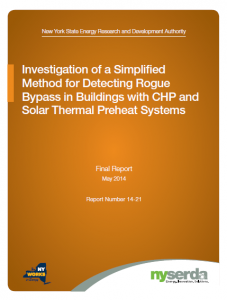Investigation of a Simplified Method for Detecting Rogue Bypass in Buildings with CHP and Solar Thermal Preheat Systems
 This study focuses on testing a simple method to detect a phenomenon called rogue bypass that affects numerous buildings with a hot water recirculation loop and has a negative impact on the performance of preheat systems such as solar thermal and cogeneration systems. It was determined in a previous study conducted at a building in The Bronx that rogue bypass was the cause of a 45% performance degradation of the solar thermal system. Since preheat systems such as solar thermal and combined heat and power (i.e. CHP or cogeneration) are becoming more and more popular in multifamily buildings, the goal of this study is to test a method that could potentially be implemented at a site as part of a feasibility study before installing a preheat system.
This study focuses on testing a simple method to detect a phenomenon called rogue bypass that affects numerous buildings with a hot water recirculation loop and has a negative impact on the performance of preheat systems such as solar thermal and cogeneration systems. It was determined in a previous study conducted at a building in The Bronx that rogue bypass was the cause of a 45% performance degradation of the solar thermal system. Since preheat systems such as solar thermal and combined heat and power (i.e. CHP or cogeneration) are becoming more and more popular in multifamily buildings, the goal of this study is to test a method that could potentially be implemented at a site as part of a feasibility study before installing a preheat system.
In the previous study, a costly flowmeter-based experiment was necessary to detect and measure rogue bypass, but a simplified methodology had been proposed to detect rogue bypass. In this study, we implemented the proposed simplified methodology on 12 recirculation loops at multifamily buildings in Manhattan and The Bronx. The methodology consists of measuring temperatures at four locations on the domestic hot water system and the status of the recirculation pump. Measurements were recorded for a period of two weeks. The advantage of this method is that it can easily be translated from one preheat system to another, since there is no measurement point on the preheat system itself.
The main metric used in this study is the temperature difference between the domestic hot water temperature and the recirculation loop temperature. One would expect this metric to be almost constant at all times, since no fluid is added to the loop between the supply and return temperature sensors in an ideal situation, and the only temperature drop is from radiative and conductive losses. Bright Power analyzed the ΔT data sets for each building and found various criteria that were identified in the previous study that would help determine the presence of rogue bypass at each building. Two tests were performed on these data sets: a visual screening and a statistical analysis.
The results of these two tests were combined to determine the probability of rogue bypass at each building. Out of the ten recirculation loops in the final data set, three of the buildings are probably experiencing significant rogue bypass. The methods described in this report appear to be promising ways to identify buildings potentially affected by rogue bypass.